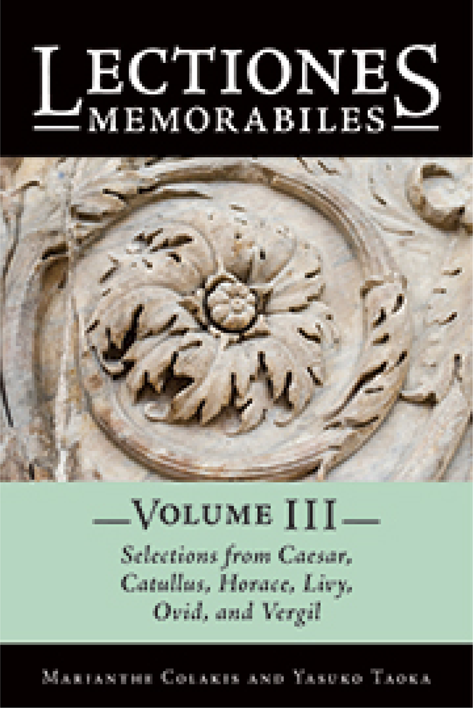
This book has the set texts for three of the themes of the IB specification for Latin, covering the themes Virgil, History and Love Poets. The Virgil section contains the last 340 lines of Book XII of the Aeneid and a couple of Eclogues. The history contains 22 chapters of Caesar (the stand of Vercingetorix) and four chapters of Livy (Hannibal in Italy). The Love Poets section has a selection of familiar and less familiar poems of Catullus, Ovid (from Amores 1) and some Horace Odes.
The book is in a series from the US publishers Bolchazy-Carducci and so will probably not be well-known to readers of JCT. It is worthy of consideration. The authors are both academics with a good track record in teaching in US high schools and colleges, and this experience is clearly reflected in this volume.
The layout has between 10 and 20 lines of Latin text on the left-hand side and notes on those lines on the rest of the page and on the facing page, minimising the amount of page-turning required. The notes, as is usual at this level, are a mixture of glosses, grammatical explanations and comments on content. There is a comprehensive Latin to English glossary at the back of the book. The book is also illustrated with a variety of black and white images from antiquity up to the current day via the Renaissance.
This layout is easy to use - all the information apart from vocabulary is available on the current page. The typeface is large, clear and attractive. The Latin words in the notes are in bold which helps draw the user's attention to them - not least to see whether there is a comment or not. I could not see what editions the texts are based on, but the book uses the letter v throughout for consonantal u.
The notes feel to be at a good level for the target audience, though they may be too grammatical for some styles of teaching. The book does not shy away from commenting on how the Latin fits together, and it does this in preference to longer glosses of phrases that some editors use. It regularly references the language to entries in a grammar book: being US in origin, this is to Allen and Greenhough's New Latin Grammar rather than Morwood and so some of the terms are those used in the US (such as ‘accusative of specification’ instead of ‘accusative of respect’; or referring to the ‘present subjunctive in the protasis of a future less vivid condition’). The upside of this is that Allen and Greenhough is available on-line section by section (http://dcc.dickinson.edu/allen-greenough/), so the entry can be brought up and projected on-screen for the whole class to see: this is probably quicker than getting everyone to turn to the relevant page in their grammar books. This ability to keep checking on the details of how Latin works could be used to improve students’ confidence in the technicalities of the language so they become a natural part of their approach to reading Latin.
The comments on content include literary terms (which are defined in an appendix), and extend to the bigger themes as well as the immediate context. They are generally clear, informative and engaging. They help build up a student's appreciation for the skill of the author, particularly for the verse selections. They can also be quite fun: I particularly enjoyed the note on Amores 1.1 line 1 where it comments that ‘Ovid lets us sneak behind the curtain, to see him waging a different kind of war with the gods…’, or the comment on Livy's use of immo as ‘sarcastic, the equivalent of ‘Yeah, right’ ’.
There is a brief introduction to each theme (between one and two sides) and to the individual authors. There is also a list of ‘Commentaries for further reading’. Both left me feeling a little short-changed and wanting more information. I would have liked a longer discussion of themes and works, and a suggestion for further secondary reading for pupils rather than a list of other, more advanced, commentaries. The explanation of metre is similar: it sets out clearly the various metrical schemes met in the book, but assumes that the basics of scansion are already known, which is unlikely to be the case. There again, most people will have their own, well-honed method of teaching this.
For those taking the IB, this book should be seriously considered. Others may also want to consider it as a reader for first year of the A level course. It gives a good variety of authors and, at 360 pages, a lot of text for the money. It could be used to prepare the way for an author of one of the set texts at A level or to give experience of a different genre. It could be a good way to help consolidate the grammar and syntax of the language and to build up students’ literary awareness prior to tackling examined authors. It could also be used as a reader to consolidate language for first year university students or for teachers wishing to focus on getting more fluency and confidence in their own Latin reading.


